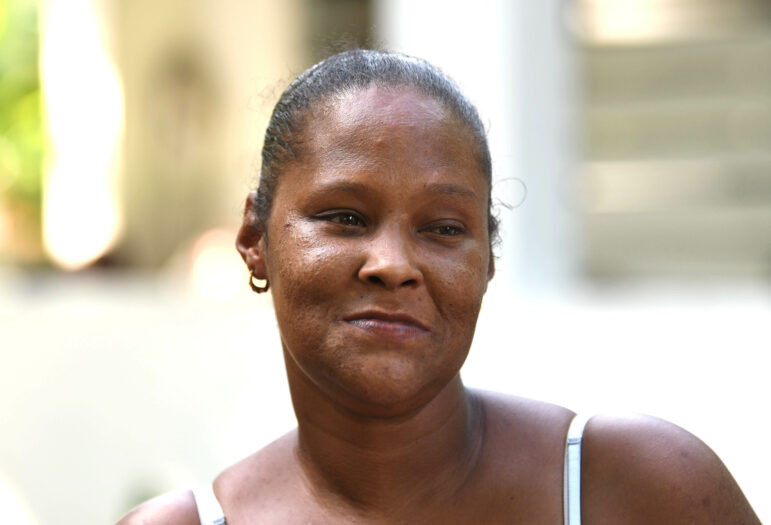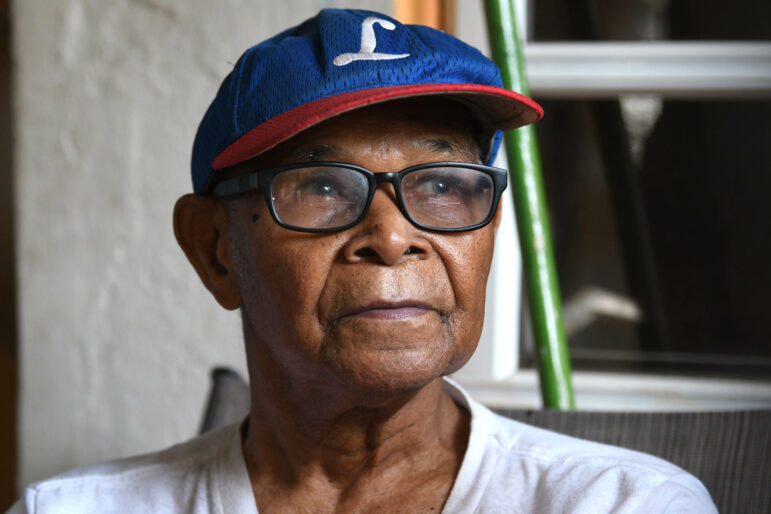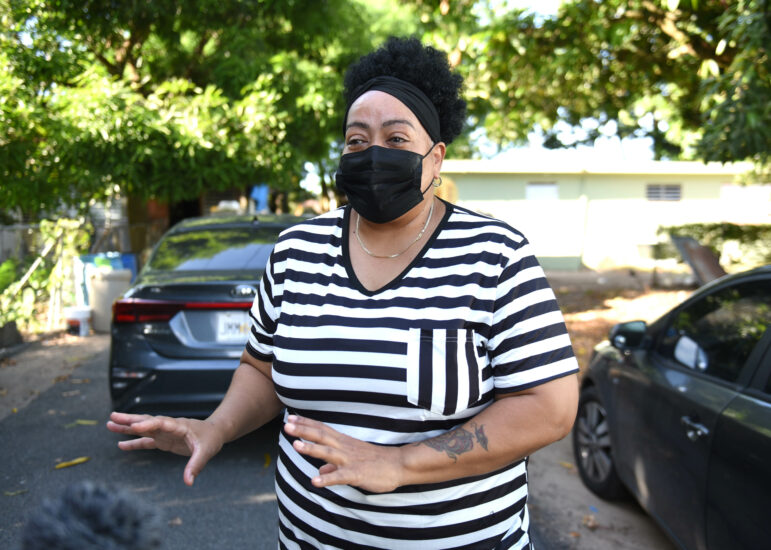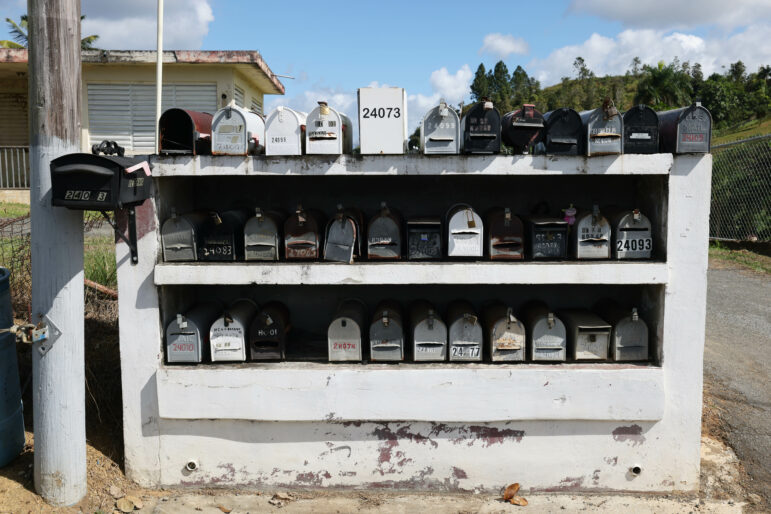Days after Hurricane Fiona hit in September 2022, Ordaliz Pizarro, 39, went to the Del Valle AIC Church in her Colobó community in Loíza. There, a group of municipal employees and volunteers were helping residents filling out the application for assistance for critical needs. She waited patiently in line for about an hour and a half. When her turn came up, she could not complete the form, because the Federal Emergency Management Agency (FEMA) system said that someone else had already filed an application using that same address.
Ordaliz, like hundreds of other people in Loíza, a poor town in the northeastern coast with a very strong african heritage and population, lives on an unnamed road in the Colobó community. Twelve years ago, she and her husband built a wooden house with a zinc roof next to her mother’s and uncle’s homes. None have a number or letter assigned to identify the house . She, like many other people in her situation, uses a relative’s mailbox number in the absence of a home number, with the limitation that mailboxes are also shared, sometimes, by dozens of people from the same family.

Photo by Ana María Abruña Reyes | Center for Investigative Journalism and Todas
“I filled it out three times and because of the address, I never got it ,” said the woman, mother of three and grandmother of two babies.
No federal or local agency has an exact figure of how many people are in the same situation of not having a physical address in Puerto Rico, but estimates from the Initiative for Civic Address System Assessment in Puerto Rico (iCasaPR) with information from the U.S. Postal Service, calculate around 300,000 homes. This figure represents nearly one million people, about a third of Puerto Rico’s population, according to the average number of persons per household and the population estimate from the Census Bureau.
Ordaliz lives below the poverty level. When Hurricane Fiona hit, her house still showed the damage caused by Hurricane Maria in 2017. Impoverished women and Black people are the most affected by this problem, said Taller Salud community organizer María Villegas Pizarro.
According to estimates from the Census Bureau’s American Community Survey (2017-2021), 58% of women-headed families live below the poverty level, compared to 44% of all families or 28% of families with a married couple. The disparity increases to 68% when women heads of household have children under 18 years of age under their care.
The situation that Ordaliz experienced repeats in the Miñi Miñi community, in Loíza. Around 30 residents went to the community center to receive technical help from students from the University of Puerto Rico’s Law School at the Río Piedras Campus (UPR-RP) to fill the applications.
“When we were filling out the forms, [the system] didn’t let us do it,” said Professor María Hernández Torrales, director of the Pro Bono Program, in an interview with the Gender Investigative Unit of media outlet Todas and the Center for Investigative Journalism (CPI, in Spanish). The reason was very simple: practically all the families in Miñi Miñi have the same address.
Hernández Torrales and her students resolved the situation by adding an extension of a number that would allow the residences to be distinguished.
“They are different homes, which were damaged differently due to the atmospheric event; They are separate families,” she added about the remedy they used so that an entire community would not be invisible.
Beyond making daily tasks difficult, like providing a service at home, authorities acknowledge that this shortcoming also sets back emergency response. Community-based organizations, such as Taller Salud in Loíza, denounce that this matter is about a need for social justice and human rights, which keeps these residents from accessing government or other services that require providing an address.
FEMA told the Gender Investigative Unit that, initially, they considered 131,986 requests for assistance from families affected by Hurricane María in Puerto Rico as “duplicate,” due to the physical address. Of those, 34% coincided with rural areas such as “Neighborhood,” “Parcel,” “Road,” “KM.” While the remaining 66% were addresses in urban areas or some that “do not show sufficient criteria to determine the precise location.”
Most cases considered as duplicates were resolved by matching differences in the applicants’ names, number of occupants or other details. If FEMA could not validate addresses in public records, the applicant was required to provide additional documents, the agency said. Finally, only 314 cases were invalidated for being duplicates.
For Hurricane Fiona, FEMA claims that their system detected duplicate addresses in 20,183 requests for assistance. The agency stated that at the end only 138 applications remained invalid for this reason, since FEMA found, in the remaining ones, that they were different houses that share the same address.
Duplicate addresses are one of the alerts that FEMA uses to detect fraud, said Idamis De Jesús, Individual Assistance specialist. In these cases, the online system halts the evaluation of the application until it can be reviewed.
“If we see that the proponent’s information is completely different, we release it so that it can be processed normally,” said De Jesús.

Photo by Ana María Abruña Reyes | Center for Investigative Journalism and Todas
De Jesus admitted, however, that the online system does not even allow someone to complete the claim on their own when a duplicate address is detected. “Unfortunately, they must call us or visit one of the centers. We check if there is any incomplete application in the system and we complete it,” said the FEMA official. At least one person interviewed who had this problem said that when going through the process they didn’t know that they could complete the claim in person at a help center.
Many of the requests whose addresses FEMA later validated respond to the fact that the victims went directly to the assistance center set. When FEMA validates a claim, it does not mean that the case is “eligible” for public insurance payment; It is just an additional control that the agency establishes for disbursement.
People who gave up completing the post-hurricane aid application because the system did not accept their address were not referred or evaluated for eligibility. FEMA was asked how many applications were left incomplete for this reason, but the agency said it did not have that data.
After Hurricane María, some residents could not claim their damages due to this situation, according to testimonies collected by the Unit.
Colobó’s community leader Mayra Cirino confronted this problem when she voluntarily supported neighbors in filling out FEMA assistance applications. “They tell them: ‘Someone already applied there.’ So many people were left without help,” she said.

Photo by Ana María Abruña Reyes | Center for Investigative Journalism and Todas
Using a PO Box as a substitute for a physical address on a FEMA claim is not an accessible alternative for everyone. Approximately six out of every 10 houses in Loíza don’t get mail, according to data collected by the organization iCasaPR. This number is due, in part, to the fact that there may be dozens of family members who get their mail in the same mailbox. Building communal mailboxes can cost thousands of dollars, due to the U.S. Postal Service’s most recent regulations, which require covered areas and lockable boxes.
Carlos Quiñones, community leader in Loíza’s Melilla sector, said when FEMA agents visited his community to assist in the damage claim process after Hurricane María, he tried to submit his case for the agency’s evaluation. The street flooding had reached nearly two feet high, water flooded the driveway, and the rain prompted leaks in the roof. In the absence of a physical address, he submitted the postal address, which he shares with his aunt, but the system did not accept the information. Quiñones gave up on completing his claim. His house still leaks when it rains, six years later.
“As important as a sidewalk”
The absence of a physical address is a multifactorial problem, said Raúl Ríos, who directed the Address Systems Administration Office of the U.S. Postal Service in Puerto Rico and the U.S. Virgin Islands in the 1990s. The jurisdiction to name the streets or local roads of public easement falls on the municipalities, according to the Municipal Code. Mayors need, however, the endorsement from the U.S. Postal Service and the approval of the municipal legislature.
Ríos said there is a lack of a “coherent and practical process for naming streets in the 78 municipalities.” There are initiatives, as is the case of the Municipality of Caguas, but not a structure or law that applies at an island wide level. The Municipality of Loíza’s Planning Office said it recently submitted a proposal for the delimitation of sectors and communities, as well as the designation of names for streets and numbers for homes. The proposal for a pilot plan was presented on October 30, 2023, for evaluation by Mayor Julia Nazario.
Planner Aurelio Castro added that in most cases it was left to developers to propose street names in the neighborhoods and submit them to the U.S. Postal Service. The absence of regulation results in several streets with the same name within municipal limits.
Ríos founded iCasaPR to help establish uniformity in address data governance. “It’s as important as having a sidewalk or having a street or a way to get to town; It’s having some type of address, which allows rescuers using a mapping system to be able to locate your house,” he said.
Often, when people call 9-1-1, they use references to explain their location: the hardware store on the corner or the church are often part of the lingo for directions that radio operators and paramedics get to locate people in an emergency.
The director of the Municipal Emergency Management Office (OMME, in Spanish) in Arecibo, Johnny Morales, confirmed that this happens frequently, and delays the response time. “The dispatcher has to call again to verify the address because they can’t get there. Sometimes, the paramedics turn on the ambulance siren and, with the person on the phone, ask: ‘Can you hear me now?’” he said.
Under typical circumstances, the Puerto Rican population has always relied on references to navigate unnamed streets or paths. But, when it is an emergency, the issue can be one of life or death, or another reason for discrimination in access to services.
“When you don’t have an address, you don’t have access to human rights,” said Jennifer De Jesús, director of Community and Leadership at Taller Salud. “The most critical thing — the ambulance — doesn’t know where to go.”
“There are entire communities that share an address. That’s a huge obstacle…That’s when I began to understand why people were rejected so much. It’s because of the addresses; The first person who applies is the only one who will be considered in the evaluation,” pointed out De Jesús.
Taller Salud carried out a community study of housing in Loíza, in which everyone surveyed said they lacked a standardized physical and postal address. The sample consisted of 366 cases distributed in seven communities in the Medianía Alta neighborhood. Sixty-five percent of the people with deteriorated or vulnerable housing in Loíza, who participated in the survey, are women. Fifty-one percent are people over 60 years old.
According to a study by iCasaPR, approximately two out of every three houses that get mail in Loíza are on nameless streets. iCasaPR uses the number of mailboxes on rural routes to make an approximation of how many houses are not reachable or have no address.
Loíza is the municipality most affected by this problem in the northeast area, even compared to the overpopulated San Juan metropolitan area, according to a graph from iCasaPR. Other municipalities located in both regions typically have less than 40% of homes with this difficulty, the study shows, while Loíza shows a rate of 81%. Only Río Grande, East of Loiza, comes close, with less than 60% of houses in this situation. The high concentration of mailboxes on rural routes in Loíza, located 18 miles (30 kilometers) East of San Juan, is comparable to that of towns along the central mountainous region or isolated towns in other regions of Puerto Rico and to the figures of the island municipality of Vieques.
The iCasaPR estimates do not take into consideration the variable of homes without postal service. In Loíza, a municipality with 52% of households below the federal poverty level, “almost all families receive their letters in a single mailbox,” said the Colobó community leader, Mayra Cirino.
The lack of individual drop boxes also limited access to free COVID-19 tests, which the Biden administration mailed. “They didn’t get delivered here because they had already identified that this person had gotten it because, since we don’t have mailboxes in front, there are 25 people getting mail at the same address and exist and live in different houses,” said Wilfredo Fuentes, community leader in the Villa Batata community.
Lack of government action
The Census Bureau’s Communications Office has admitted, in official documents, that the lack of standardization in addresses in Puerto Rico not only complicates mail delivery, but also “delays disaster recovery.” It has also led to greater investment by the U.S. Census Bureau to conduct surveys on the islands of Puerto Rico.
The federal agency annually coordinates a technological innovation accelerator in which it has integrated developers from Puerto Rico, twice, to come up with alternatives to the problem of the lack of addresses. The applications developed would make it easier for municipalities or community-based organizations, such as Taller Salud, to name streets and list houses. But implementation, at the local level, has not happened.
In its 2018 Recovery Plan, the government of Puerto Rico recognized as “an additional complicating factor” that the addressing system makes it difficult for emergency services and service providers to reach homes and businesses.

Photo by Brandon Cruz González | Center for Investigative Journalism
Ex Governor Ricardo Rosselló’s administration estimated the cost of standardizing the addressing system, installing new signs and address numbers, and updating government databases with new property addresses at $75 million to $200 million.
In December 2021, the government of Puerto Rico awarded a $52 million contract to firm Tetra Tech to develop a standardized database of all addresses and a georeferenced map with all properties in the archipelago, but Pedro Pierluisi’s administration canceled the contract alleging a conflict of interest for not reporting a business relationship with another contractor from the Housing Department.
In April 2023, the government opened an informal bid to develop a geographic information database. It will include a mapping portal for the Geospatial Framework Program (GeoFrame) subsidized with CDBG recovery and mitigation funds.
Housing Secretary William Rodríguez, said the bid, released in April 2023, is still under evaluation by a committee.
Rodríguez said the website will draw on the information already available from the Municipal Revenue Collection Center’s (CRIM, in Spanish) digital cadaster, the Property Registry, census, and postal mail information, in addition to in-person visits.
“We’re going to be validating and matching the information to have the data correct as possible and that, in turn, will be georeferenced,” Rodriguez said.
The informal bidding requires participating companies to have knowledge in GIS, database configuration and interpretation of aerial photography. However, when it comes to data standardization, it only asks that the company have “experience integrating non-standardized and non-uniform data.”
Ríos pointed out that, for the standardization of existing addresses, Puerto Rico requires adapted technology because the territory’s addresses are different. “Every geospatial project should have specialists in the subject of addresses when creating new geospatial databases. The absence of that local experience has been the downfall of many previous projects in the island,” he said.
The Puerto Rico Planning Board stated in writing that it will provide uniform guidelines to municipalities to carry out the street naming and structure numbering processes. However, it referred to Housing the questions about the date of publication of these guides and the funds available for this task. Meanwhile, Rodríguez confirmed that the GeoFrame RFP does not include a funding item for the assignment of physical addresses. The program only has $3 million available to assist municipalities and agencies in collecting information, such as the location of municipal roads, he said.


